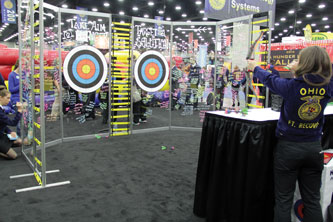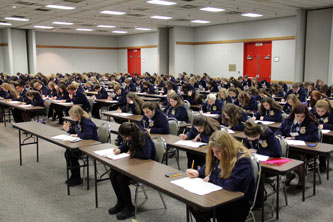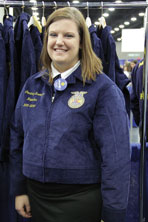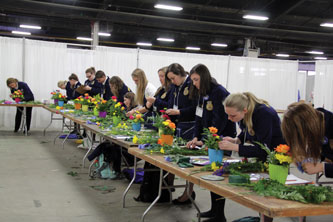12/31/2015
Floriculture’s Future
Jennifer Zurko
“We don’t just talk about plows, cows and sows anymore,” said Dr. Dwight Armstrong, CEO of the National FFA, which used to stand for Future Farmers of America. I say “used to” because the FFA is trying to change the thinking that it’s only for young people who plan on pursuing a career in Agriculture. That focus has changed to include students who are interested in other opportunities that the FFA helps to support and the organization is working hard to communicate this.
This past October, I attended the National FFA Convention—an annual event that’s part trade show, part educational experience and part networking/relationship building for about 65,000 high school students who are chosen by their local chapters to attend. It was a sea of blue, as each member proudly wears the traditional blue FFA corduroy jacket with their home state stitched above the emblem.
It had been years since
GrowerTalks, or any horticulture trade publication for that matter, attended the National Convention, especially since Floriculture, as they call it, didn’t seem to be as much of a focus for the FFA in years past. However, that’s starting to change with the FFA’s new marketing campaign and some much-needed improvements to the Floriculture concentration in general.
Finding our future
The FFA has been around for a while—since 1928—and during the last few years, the FFA has experienced record membership, with 630,000 total members as part of 7,757 chapters throughout the United States. And these kids are interested in more than just traditional farming. The FFA offers high school students a way to figure out what they want to be when they grow up with programs that support their interests under the umbrella of Agriculture, Veterinary Science and Floriculture.
“There are so many opportunities within Ag,” said Dr. Armstrong. “We need to engage with them so they can think about a future career.” These possible careers can be in:
- Family & Consumer Services
- Management & Business
- Information Technology
- Marketing
- Science & Engineering
- Food & Biomaterials Production
- Education
- Communications
- Government Services
The possibilities are almost endless and the FFA will be working hard to face its challenges, which includes a question of how to let the students know of these opportunities, as well as addressing a major shortage of Ag teachers, who have been their biggest grassroots supporters.
But the FFA can’t do it alone—they will be relying heavily on their sponsors and company supporters to help them ensure the talent pool never runs dry.
“We need talented people who understand technology, problem solvers for our industry, in government, education and philanthropy, who understand Ag,” said Dr. Armstrong, who openly challenged FFA supporters during the sponsorship breakfast.
By 2020, there will be five generations in the workforce, he said, and if companies want to tap into some of that young talent, they need to identify the career opportunities and connect with them by supporting local schools, offering more internships and posting jobs where young people can find them—on social media and websites like AgCareers.com. “We need leaders and workers with employable skills. If you want these young people, you have to go and work at it,” he told the sponsors.
Besides actively lobbying to keep Ag courses in high schools, part of FFA’s new promotional plan is its partnership with Discovery Education, which is helping the organization build its first online career program for food science. A common theme I saw throughout the convention addressed what we’ve been hearing for the last five years—addressing concerns about food shortages and waste, and the origins of our food supply.
“These young people want to make a difference,” said Dr. Armstrong. “They want to combine their passion with career opportunities and we need to help prepare them to achieve success for the future.”
Moving floriculture forward
Now, for the Floriculture sector of the FFA, there will be some changes to the Career Development Event (CDE) for the National Convention, which includes various areas where the students compete for awards and scholarships given at the banquet on the last night. The students take a 50-question general knowledge test, create bouquets and corsages, identify different plants and diseases, and go through mock interviews, sales pitches and order taking.
Right now, the CDE is geared very much toward the florist market, but starting in 2017, the program will include more Horticulture-focused events, like growing procedures for seed and cuttings, an updated plant ID list that includes more annuals and perennials (which was referenced through Ball Seed, who’ll also be supplying all of the supplies for the competition for the next seven years), and more of a focus on nutrient deficiencies instead of just diseases. The phone sales portion will be replaced by a digital media contest and there will be an equipment ID part, which will test the students on everything from pH readers to Dosatron injectors.
“The changes to the Floriculture CDE guidelines that were created by the revision committee were created to encompass the floriculture industry as a whole from the greenhouse/production side of the industry all the way to the floral design/creative side,” said Melissa Riley, a horticulture area teacher for the state of Georgia. “The changes will help the students get a well-rounded impression of the industry and showcase career options for them that they may never have known existed.”
Along with the implementations, Melissa was named as the new superintendent in charge of the National FFA Floriculture CDE. Part of her job as an area educator is that she works with hort teachers and area FFA chapters and officers, so it was an ideal fit.
What’s not common knowledge is that many young people who choose to pursue horticulture as a career were FFA members and are now working in our industry. Most of them agree that without their involvement in this extracurricular program, they wouldn’t be where they are today.
Layci Gragnani was an FFA member at Kerman High School in California. She started showing sheep, but took floriculture/horticulture her junior and senior year, which led her to enroll at Cal Poly University to major in horticulture. She now handles marketing for Star Roses.
“I can honestly say that if I wouldn’t have done FFA, I probably wouldn’t have gone to Cal Poly and I probably wouldn’t be in horticulture,” said Layci. “It exposes you to a lot of different things at a young age and helps guide you in the direction that you want to go in.”
Josh Stephens just earned a job as an arborist sales rep for Davey Tree Service in Nashville, closer to his hometown in Kentucky. He was a member of the revision committee that pushed for the new changes, which will not only affect the national competition, but also hort classes nationwide. He said that the Floriculture CDE will now be about 60% greenhouse focused and 40% florist focused.
Josh was an FFA member for six years, served as a chapter president and was a participant in the CDE at the National Convention. For Josh, the FFA helped shape his professional life.
“Me sitting here talking to you started with the FFA,” said Josh. “I feel like many other people have those stories about how their careers began. It teaches you things that your peers, at that level, aren’t learning. It’s not just putting seeds in the ground; it’s every aspect of plant science. The FFA makes learning fun and that’s the key.”
GT
Most of the bo oths were fun and interactive, especially the ones built by the FFA. This one invited them to “Take Aim @ Hunger” and “Target a Solution” using a bow and arrow. They also wrote ideas on how to fight hunger on the glass panels, including “Eat everything on your plate so you aren’t being wasteful!”
oths were fun and interactive, especially the ones built by the FFA. This one invited them to “Take Aim @ Hunger” and “Target a Solution” using a bow and arrow. They also wrote ideas on how to fight hunger on the glass panels, including “Eat everything on your plate so you aren’t being wasteful!”
About 172 students from 43 states got to compete in the Floriculture Career Development Event (CDE). The first thing they have to do is take a test comprised of 50 questions that they have to complete in one hour to gauge their general knowledge. Questions include: “True or False: Pinching naturally accelerates a plant’s branching.” About 20 of the  questions come from the Ball RedBook, I’m proud to say.
questions come from the Ball RedBook, I’m proud to say.
You should have noticed a theme throughout these photos and on our cover—a blue corduroy jacket that ALL of the students wear to the National Convention. It’s extremely important to these kids and they wear them with pride. Unfortunately, some students who get to attend Convention can’t afford to buy the jacket. So the FFA has a program called “Give the Gift of Blue” where advisors and teachers can nominate a needy student to get a blue jacket for free. Donations from the FFA’s sponsors help pay for these.
One of those lucky students was Courtney. She was  stu
stu ck wearing her cousin’s jacket until she earned one of her very own. She had tears in her eyes when she talked about it, “Now I feel like I’m officially part of this event.” It’s amazing what a small token or donation can do to change someone’s life.
ck wearing her cousin’s jacket until she earned one of her very own. She had tears in her eyes when she talked about it, “Now I feel like I’m officially part of this event.” It’s amazing what a small token or donation can do to change someone’s life.
One of the other competitions the Floriculture students compete in is creating and designing a bouquet vase. They have 20 minutes to complete a bouquet (45 minutes for the group one) … then each one is judged by local florists and the winners are announced at the banquet on the last night.